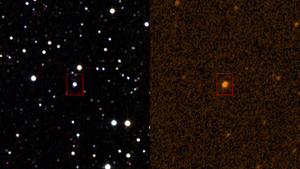| Observation data Epoch J2000.0 Equinox J2000.0 (ICRS) | |
|---|---|
| Constellation | Cygnus |
| Right ascension | 20h 06m 15.45265s[1] |
| Declination | +44° 27′ 24.7909″[1] |
| Apparent magnitude (V) | +11.705±0.017[2] |
| Characteristics | |
| KIC 8462852 A | |
| Evolutionary stage | Main sequence[2] |
| Spectral type | F3V[2] |
| B−V color index | 0.557 |
| V−R color index | 0.349 |
| R−I color index | 0.305 |
| J−H color index | 0.212 |
| J−K color index | 0.264 |
| KIC 8462852 B | |
| Spectral type | M2V[3] |
| Astrometry | |
| KIC 8462852 A | |
| Radial velocity (Rv) | −0.46±3.91[1] km/s |
| Proper motion (μ) | RA: −10.375±0.012 mas/yr[1] Dec.: −10.273±0.011 mas/yr[1] |
| Parallax (π) | 2.2545 ± 0.0099 mas[1] |
| Distance | 1,447 ± 6 ly (444 ± 2 pc) |
| Absolute magnitude (MV) | 3.08[2][4] |
| KIC 8462852 B | |
| Proper motion (μ) | RA: −10.097±0.231 mas/yr[5] Dec.: −10.610±0.254 mas/yr[5] |
| Parallax (π) | 2.2470 ± 0.1620 mas[5] |
| Distance | 1,500 ± 100 ly (450 ± 30 pc) |
| Position (relative to Tabby's Star)[3] | |
| Component | KIC 8462852 B |
| Epoch of observation | 2019 |
| Angular distance | 1951.88±0.06 mas |
| Position angle | 96.062±0.004° |
| Projected separation | 880±10 AU |
| Details | |
| KIC 8462852 A | |
| Mass | 1.43[2] M☉ |
| Radius | 1.58[2] R☉ |
| Luminosity (bolometric) | 4.68[2] L☉ |
| Surface gravity (log g) | 4.0±0.2[6] cgs |
| Temperature | 6750±120[2] K |
| Metallicity | 0.0±0.1[2] |
| Rotation | 0.8797±0.0001 days[2] |
| Rotational velocity (v sin i) | 84±4[2] km/s |
| KIC 8462852 B | |
| Mass | 0.44±0.02[3] M☉ |
| Radius | 0.45±0.02[3] R☉ |
| Temperature | 3720±70[3] K |
| Other designations | |
TYC 3162-665-1, Boyajian's Star, WISE J200615.45+442724.7, KIC 8462852, NSVS 5711291, Gaia DR2 2081900940499099136, 2MASS J20061546+4427248, UCAC4 673-083862, TIC 185336364, APASS 52502626 | |
| Database references | |
| SIMBAD | data |
| B | |
Tabby's Star (designated as KIC 8462852 in the Kepler Input Catalog and also known by the names Boyajian's Star and WTF (Where'sTheFlux?)[7] Star, is a binary star in the constellation Cygnus approximately 1,470 light-years (450 parsecs) from Earth. The system is composed of an F-type main-sequence star and a red dwarf companion.
Unusual light fluctuations of Tabby's Star, including up to a 22% dimming in brightness, were discovered by citizen scientists as part of the Planet Hunters project. The discovery was made from data collected by the Kepler space telescope, which observed changes in the brightness of distant stars to detect exoplanets. Several hypotheses have been proposed to explain the star's large irregular changes in brightness, but as of 2024[update], none of them fully explain all aspects of the resulting light curve. It has been suggested that it is an alien megastructure, but evidence tends to discount this suggestion.[8]
In September 2019, astronomers reported that the observed dimmings of Tabby's Star may have been produced by fragments resulting from the disruption of an orphaned exomoon. Tabby's Star is not the only star that has large irregular dimmings, but other such stars include young stellar objects called YSO dippers, which have different dimming patterns.[citation needed]
- ^ a b c d e Cite error: The named reference
Gaia DR3 Awas invoked but never defined (see the help page). - ^ a b c d e f g h i j k Cite error: The named reference
arXiv:1509.03622was invoked but never defined (see the help page). - ^ a b c d e Pearce, Logan A.; Kraus, Adam L.; Dupuy, Trent J.; Mann, Andrew W.; Huber, Daniel (2021). "Boyajian's Star B: The Co-moving Companion to KIC 8462852 A". The Astrophysical Journal. 909 (2): 216. arXiv:2101.06313. Bibcode:2021ApJ...909..216P. doi:10.3847/1538-4357/abdd33. S2CID 234354291.
- ^ Cite error: The named reference
Bibcode:2013ApJS..208....9Pwas invoked but never defined (see the help page). - ^ a b Cite error: The named reference
Gaia DR3 Bwas invoked but never defined (see the help page). - ^ Cite error: The named reference
Marengo2015was invoked but never defined (see the help page). - ^ Cite error: The named reference
PSU-20151015was invoked but never defined (see the help page). - ^ McKie, Robin (27 April 2024). "'Is it aliens?': how a mysterious star could help the search for extraterrestrial life". The Observer.
